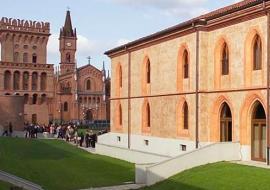The origins of this aristocratic wine are lost in legend. Some say that the Gauls originally arrived in Italy precisely because they were attracted by a certain excellent wine called ‘Barbaritium’. Others relate that Barbaresco derived its name from the barbarian hoards that caused the fall of the Roman Empire.
It is probably true that, during Roman times, the hill where the village of Barbaresco now stands was intensely wooded and the Ligurian tribes used these forests as a hide-out to elude the deadly Roman cavalry. The Romans called this area ‘barbarica silva’, or ‘wild woods’ because it was situated on the very edge of their domains and was risky territory owing to the barbarian presence.
Professor Domizio Cavazza, the first ever headmaster of the Enological School of Alba was also the first to delineate the properties of this wine during the same period – around the second half of the 19th century - in which Count Cavour, the Marquess of Falletti and the Savoy Royal Family were all taking an interest in Barolo, the other grand red produced from the Nebbiolo grape.
Since these times, Barbaresco has always been considered Barolo’s ‘twin’, arriving more or less simultaneously at the same set of regulatory laws, stimulating the foundation of the Consortium in 1934, becoming one of the first Italian Doc wines in 1966 and, in 1980, one of the first Docg wines.
Barbaresco is produced entirely from Nebbiolo grapes and presents an intense and brilliant colour ranging from ruby to garnet red. The bouquet is a stimulating combination of fruit including raspberries and redberry jam, geraniums and violets but also green pepper, cinnamon, nutmeg, hay wood, toasted hazelnuts, vanilla and even aniseed.
Barbaresco must be left to age at least two years in oak – after four years the title ‘Reserve’ can be applied. It is best when aged from five to ten years but may be even longer living. Various interpretations of the wine are available on the market, including more modern versions prepared in small wooden barrels.
The area of production includes the entire territory of the villages of Barbaresco, Treiso and Neive, plus part of the territory of the Alba municipality.This wine is produced by both small wineries and prestigious co operative wineries, and includes some world-famous names. The Barbaresco Regional Enoteca Wine Shop is situated in the village of Barbaresco itself, and most local Barbarescos can be tasted here. The ‘Enoteca’ organises many wine and food tasting events for visitors throughout the year: phone numbers and addresses can be found in the list included in this brochure.
Working together with the ‘Enoteca’ and the Province of Cuneo, the Consortium has defined areas of especially high quality of cultivation, known as ‘Menzioni Geografiche Aggiuntive’ (additional geographical definitions) or ‘crus’. It is possible to describe these areas as ‘crus’ even though the word belongs to a completely different historical and economical context.
The Definitions do not constitute an official list but are an additional indication of the precise origin of a wine, even down to hill, hamlet, vineyard or farm where grapes are grown.

| << | June 2022 | >> | ||||
| Sun | Mon | Tue | Wed | Thu | Fri | Sat |
| 1 | 2 | 3 | 4 | |||
| 5 | 6 | 7 | 8 | 9 | 10 | 11 |
| 12 | 13 | 14 | 15 | 16 | 17 | 18 |
| 19 | 20 | 21 | 22 | 23 | 24 | 25 |
| 26 | 27 | 28 | 29 | 30 | ||